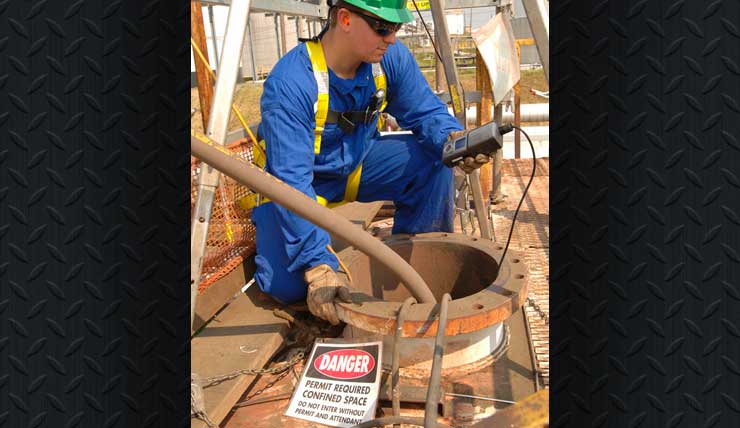
Continuous monitoring of the atmosphere within a confined space has always been considered a best practice, but is difficult and often impractical to implement. In this Ask John we answer the question about how the flexibility of wireless gas detectors is changing the way we test the atmosphere inside confined spaces.
Previously, the attendant assigned to the confined space entry monitored the atmosphere inside the space with a portable gas detector, or a sampling pump and a piece of tubing, or a probe. Confined space gas detector kits are an example of this type of equipment.
But continuously monitoring the atmosphere throughout the entire space where the work is being performed is much more challenging.

A confined space attendant’s job can be made easier with wireless gas detectors.
Wireless gas detectors change that scenario
Wireless mesh technology embedded within gas detectors in systems such as Industrial Scientific’s LENS Wireless communication system enables them to communicate with each other wirelessly at a peer-to-peer level.
Operators carrying LENS-enabled gas detectors inside the confined space share their readings with the detector of an attendant stationed outside the space. This allows the outside attendant to see the readings and monitor the atmosphere through each of the entrants’ wireless gas detectors.
The repeating capabilities of wireless gas detectors in the mesh network lets workers go deep inside a confined space far away from the entrance where they could never be seen directly, and yet communicate atmospheric readings back to the attendant at the entrance.
Expanded role
Wireless gas detector technology is expanding the role of the attendant in confined space entry.
One attendant is typically assigned to monitor the entrance of every confined space. Wireless technology, however, permits one attendant to monitor the activities of multiple confined space entries from a central vantage point.
Wireless video cameras let an attendant view the activities of workers in multiple entries. And mesh networking of the gas detectors allows one attendant to monitor the atmosphere in multiple confined spaces.
Best practice for confined space entry is outlined in the Quick Guide document published by Worksafe New Zealand, “Confined spaces: planning entry and working safely in a confined space“.
ePermitting
The confined space entry permit itself will soon be impacted by wireless technology as well. Electronic permitting or ePermitting systems are being developed to automate the permit issuing process. Here’s how it works…
An electronic form on a smart device is accessed at the point of entry and all the appropriate procedural checklists are completed.
Gas readings from atmospheric testing with wireless gas detectors are transferred to the permit automatically, and all entry personnel sign off on the permit electronically.
A wireless system used to assign gas detectors and other traceable tools and equipment to the entrants also allows the entrants’ names to be automatically recorded on the permit.
The permit is then uploaded to a database where it can be stored permanently and viewed during the entry.
The permit is automatically updated with gas readings from continuous monitoring or periodic testing and as the work progresses or entry conditions change.
ePermitting is simply another example of how wireless gas detector technology can increase the efficiency and reduce the cost of entering a confined space.
Final thoughts
Although it seems like only yesterday, it really has been 25 years since we were required to complete that first confined space entry permit.
If we continue to embrace wireless gas detector technology and the benefits it brings us, maybe those confined space entries tomorrow won’t seem so confined.
If you’d like to enquire about wireless gas detectors, here’s what to do…
- Email gas@entec.co.nz, or
- Phone (06) 758-3030 ext 2 to talk to a wireless gas detection expert.
A version of this article first appeared here. Revised and republished with permission.